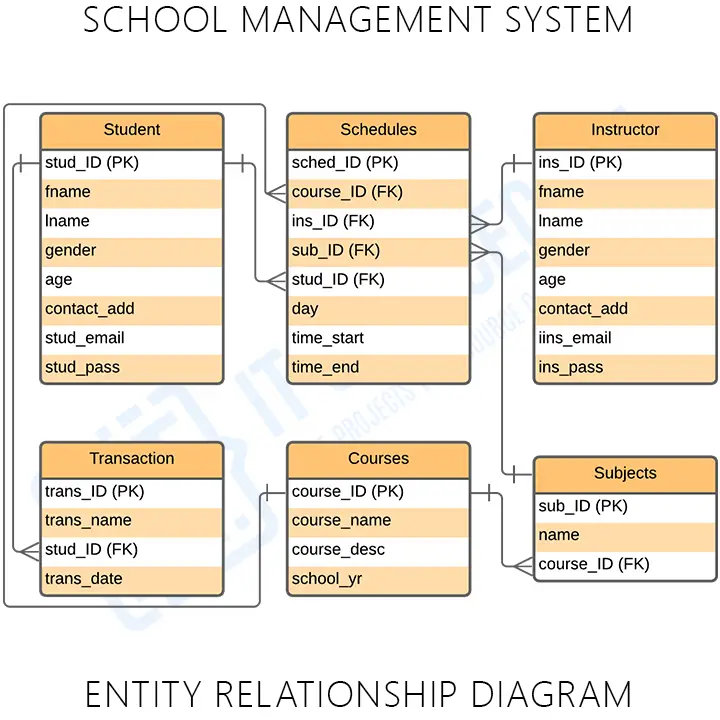The ER diagram for school management system shows the relationships of the system’s entities that build its database design. This describes the logical structure of the system’s database or data storage. It is done by identifying the school management process entities, their properties, and the interactions between them.
The school management system database design is sketched out using ER (entity-relationship) diagram. This sketch becomes the actual basis of the system’s data storage that will serve as data destination and source.
ER Diagram for School Management System: Details
The table shows the overall description of the ER Diagram for School Management System. It has a complete overview of the project’s information.
| Name: | School Management System ER Diagram |
| Abstract: | The school management system ER diagram depicts the relationship between various entities. It can be thought of as a blueprint for your system (project) structure. |
| Diagram: | ER Diagram is also known as Entity Relationship Diagram |
| Tools Used: | Diagraming tools that provide ER diagram symbols. |
| Users: | School Admin and Staff and the students. |
| Designer: | ITSourceCode.com |
What is School Management System?
A school management system is a platform for software that helps your school run more smoothly by digitizing and automating many academic and administrative tasks.
In schools, where thousands of sensitive and vital data must be securely held, school management systems facilitate the flow of information. Students can simply update and retrieve their information online with adequate database management.
School Management System Features
- School Management – Bank Management is the main feature of this system wherein ER diagram contains the basic details of the school. This basic information was composed of the courses and programs offered.
- Student Management – This feature plays a big role in the system because this gathers important information about the students. This information was used to track their transactions and other important matters regarding the system.
- Course and Subjects Management – The school admin will have to set the selected courses for every student, then assign appropriate instructors to the subjects covered by each course.
- Instructors Management – This system handles the instructors’ information as well as their complete schedule of classes and all that were needed to be done in managing instructors.
- Transaction and Scheduling Management – This feature will store the transactions made by the students and instructors including their information and their schedules for every subject and timetables.
What is an ER Diagram?
In DBMS, the ER Diagram of school management system is also known as the system’s database design. It is the graphical depiction of relationships between all the entities involved in the system. Its major components are Entities, Attributes, and Relationships.
Importance of ER Diagram
The importance of ER diagram for school management system is to help in modeling its data storage or database. It is the basis of the project’s database foundation for construction.
The school management system entity-relationship diagram (ERD) also aids in defining the data types to be stored such as their attributes and characteristics.
Simple ER Diagram for School Management System
ER Diagram of Bank Management System shows the system entity relationships in each entity and their supposed functions in each relationship.

Based on the image above, the ER diagram for school management system tables are; students, instructors, schedules, transactions, courses, and subjects.
The tables are made to meet the required specification of the system and provide much more specific details of each entity within the system.
School Management System ER Diagram Description
This School management system database design was made based on managing school requirements. The system can encode students’ information.
School admin can have access to the students’ status and information for the important transactions. They can handle the data needed in managing student and instructors/teachers’ files as well as the transactions made by their enrollees.
School Management System ER Diagram Tables
These tables below provide the complete database table details such as Field Name, Descriptions, data types, and character lengths. Each of these tables represents the characteristics and the attributes of data storage.
The field column presents the names of each database’s attributes, the description column gives the complete thought of each attribute, the type column is their data type and the length is for their character lengths.
Table Name: Student
| Field | Description | Type | Length |
| stud_ID (PK) | Student ID | Int | 11 |
| fname | Student First Name | Varchar | 255 |
| lname | Student Last Name | Varchar | 255 |
| gender | Student Gender | Int | 11 |
| age | Student Age | Int | 11 |
| contact_add | Contact Address | Int | 11 |
| stud_email | Student Email | Varchar | 255 |
| stud_pass | Student Password | Varchar | 255 |
Table Name: Instructor
| Field | Description | Type | Length |
| ins_ID (PK) | Instructor ID | Int | 11 |
| fname | Instructor First Name | Varchar | 255 |
| lname | Instructor Last Name | Varchar | 255 |
| gender | Instructor Gender | Int | 11 |
| age | Instructor Age | Int | 11 |
| contact_add | Contact Address | Int | 11 |
| ins_email | Instructor Email | Varchar | 255 |
| ins_pass | Instructor Password | Varchar | 255 |
Table Name: Course
| Field | Description | Type | Length |
| course_ID (PK) | Course ID | Int | 11 |
| course_name | Course Name | Varchar | 30 |
| course_desc | Course Description | Varchar | 30 |
| school_yr | School Year | Int | 11 |
Table Name: Subjects
| Field | Description | Type | Length |
| sub_ID (PK) | Subject ID | Int | 11 |
| name | Subject Name | Varchar | 255 |
| course_ID (FK) | Course ID | Int | 11 |
Table Name: Schedules
| Field | Description | Type | Length |
| sched_ID (PK) | Schedule ID | Int | 11 |
| course_ID (FK) | Course ID | Int | 11 |
| sub_ID (FK) | Subject ID | Int | 11 |
| ins_ID (FK) | Instructor ID | Int | 11 |
| stud_ID (FK) | Student ID | Int | 11 |
| day | Day of schedule | Date | |
| time_start | Starting Time | Time | |
| time_end | Time Ended | Time |
Table Name: Transactions
| Field | Description | Type | Length |
| trans_ID (PK) | Transaction ID | Int | 11 |
| trans_name | Transaction Name | Int | 11 |
| stud_ID (FK) | Student ID | Int | 11 |
| trans_date | Transaction Date | Date |
The tables given will be the basis for developers on how would they do the school management system database design.
It has the complete description of the database and they will put this into the program or data storage the same as the names given to each of the tables. They will create a database with the attributes given as well as the value of each attribute.
School Management System ER Diagram [PDF]
The ER Diagram for School Management System in DBMS PDF provides the information explaining the concepts of the project database.
You may apply this information to your capstone project. You can also use it directly or modify its content depending on your project’s requirements.
How to create an Entity-Relationship (ER) Diagram
Time needed: 5 minutes
Steps in building the ER Diagram for School Management System with Cardinality Ratio.
- Step 1: Familiarize the ER Diagram (Entity Relationship Diagram) Symbols and Cardinality
Entity Relationship Diagram – shows the structure of data types in a project. It uses symbols to clarify its parts and relationships. Their symbols and applications must be familiarized before you build the ER Diagram.
ER Diagram Symbols:
• Field – are the parts of a table that define the entity’s characteristics. In the database that the ERD models, attributes are commonly thought of as rows.
• Keys – is a technique to categorize data qualities. It is used to organize ER diagrams and assist users in modeling their databases to ensure that they are efficient. This is also used to connect different tables in a database.
– Primary Key: identifies a single entity instance which means a unique attribute or set of attributes.
– Foreign Key: is produced when data attributes have one too many relationships with other entities. - Step 2: Finalize the entities included
Start designing your ER Diagram by finalizing the entities that must be included in your school management system.
This entity is represented by a rectangle, and you’ll want to leave plenty of room for them in future phases so you may add them to your design. - Step 3: Add the attributes of each entity
After finalizing the entities, think about the qualities you’ll need to characterize each entity. The details of the various entities outlined in a conceptual ER diagram are supplied as attributes.
Characteristics of an entity, a many-to-many relationship, or a one-to-one relationship are all examples of attributes. Multivalued attributes can be assigned to several values. - Step 4: Describe the relationships (cardinality) between entities and attributes
To plot relationships between the ERD you will need the entities, their attributes, and relationships. You will base the data structure from the evaluated information to have the exact Entity Relationship Diagram.
Conclusion:
ER (entity-relationship) diagram is only one of the diagrams used to design and develop the School Management System. Each of the diagrams you design and create will help you in presenting your ideas and impart your abilities.
Creating the ER diagram will help you perceive the back end of the software which will hold all the data that’ll enter and exit the system. To learn more about the ER Diagrams and more, check out the related and recommended articles below.
Related Articles:
- University Management System ER Diagram
- Barangay Information System ER Diagram
- ER Diagram for Online Ordering System
- ER Diagram for Bank Management System
- ER Diagram for Hotel Management System
Inquiries
If you have inquiries or suggestions about the School Management System ER Diagram, just leave us your comments below. We would be glad to know to concerns and suggestions and be part of your learning.
Keep us updated and Good day!

